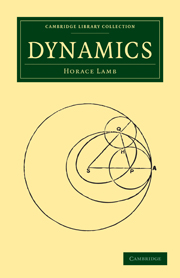Book contents
- Frontmatter
- PREFACE
- Contents
- CHAPTER I KINEMATICS OF RECTILINEAR MOTION
- CHAPTER II DYNAMICS OF RECTILINEAR MOTION
- CHAPTER III TWO-DIMENSIONAL KINEMATICS
- CHAPTER IV DYNAMICS OF A PARTICLE IN TWO DIMENSIONS. CARTESIAN COORDINATES
- CHAPTER V TANGENTIAL AND NORMAL ACCELERATIONS. CONSTRAINED MOTION
- CHAPTER VI MOTION OF A PAIR OF PARTICLES
- CHAPTER VII DYNAMICS OF A SYSTEM OF PARTICLES
- CHAPTER VIII DYNAMICS OF RIGID BODIES. ROTATION ABOUT A FIXED AXIS
- CHAPTER IX DYNAMICS OF RIGID BODIES (CONTINUED). MOTION IN TWO DIMENSIONS
- CHAPTER X LAW OF GRAVITATION
- CHAPTER XI CENTRAL FORCES
- CHAPTER XII DISSIPATIVE FORCES
- CHAPTER XIII SYSTEMS OF TWO DEGRESS OF FREEDOM
- APPENDIX. NOTE ON DYNAMICAL PRINCIPLES
- INDEX
CHAPTER II - DYNAMICS OF RECTILINEAR MOTION
Published online by Cambridge University Press: 07 September 2010
- Frontmatter
- PREFACE
- Contents
- CHAPTER I KINEMATICS OF RECTILINEAR MOTION
- CHAPTER II DYNAMICS OF RECTILINEAR MOTION
- CHAPTER III TWO-DIMENSIONAL KINEMATICS
- CHAPTER IV DYNAMICS OF A PARTICLE IN TWO DIMENSIONS. CARTESIAN COORDINATES
- CHAPTER V TANGENTIAL AND NORMAL ACCELERATIONS. CONSTRAINED MOTION
- CHAPTER VI MOTION OF A PAIR OF PARTICLES
- CHAPTER VII DYNAMICS OF A SYSTEM OF PARTICLES
- CHAPTER VIII DYNAMICS OF RIGID BODIES. ROTATION ABOUT A FIXED AXIS
- CHAPTER IX DYNAMICS OF RIGID BODIES (CONTINUED). MOTION IN TWO DIMENSIONS
- CHAPTER X LAW OF GRAVITATION
- CHAPTER XI CENTRAL FORCES
- CHAPTER XII DISSIPATIVE FORCES
- CHAPTER XIII SYSTEMS OF TWO DEGRESS OF FREEDOM
- APPENDIX. NOTE ON DYNAMICAL PRINCIPLES
- INDEX
Summary
Dynamical Principles. Gravitational Units.
The object of the science of Dynamics is to investigate the motion of bodies as affected by the forces which act upon them. Some system of physical assumptions, to be justified ultimately by comparison with experience, is therefore necessary as a basis. For the present we consider specially cases where the motion and the forces are in one straight line.
The subject may be approached from different points of view, and the fundamental assumptions may consequently be framed in various ways, but the differences must of course be mainly formal, and must lead to the same results when applied to any actual dynamical problem. In the present Article, and the following one, two distinct systems are explained. Both systems start from the idea of ‘force’ as a primary notion, but they differ as to the principles on which different forces are compared.
The first assumption which we make is in each case that embodied in Newton's ‘First Law,’ to the effect that a material particle* persists in its state of rest, or of motion in a straight line with constant velocity, except in so far as it is compelled to change that state by the action of force upon it. In other words, acceleration is the result of force, and ceases with the force. This is sometimes called the ‘law of inertia.’
The first of the two systems to be explained proceeds from a purely terrestrial and local standpoint, and adopts the system of force-measurement, in terms of gravity, with which we are familiar in Statics.
- Type
- Chapter
- Information
- Dynamics , pp. 17 - 54Publisher: Cambridge University PressPrint publication year: 2009First published in: 1923



